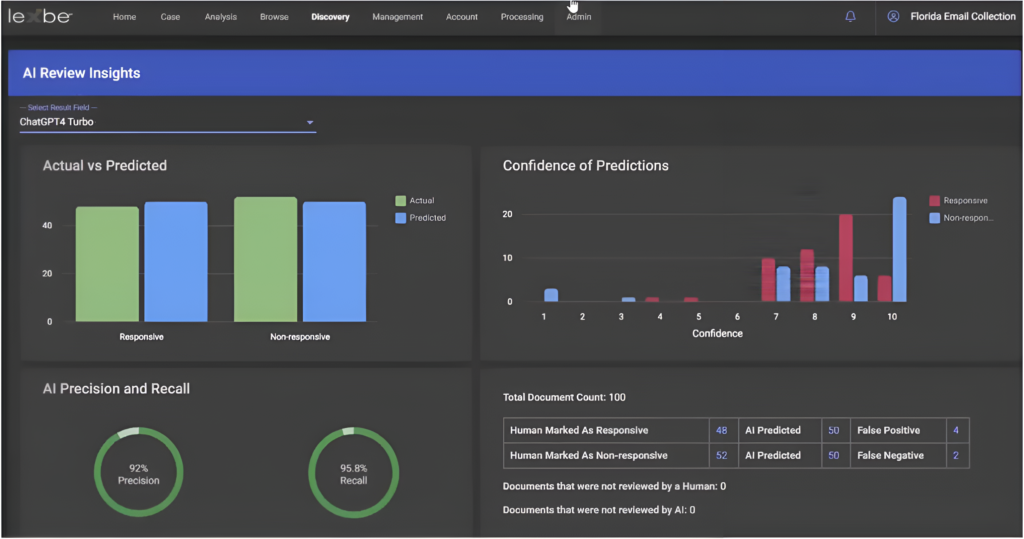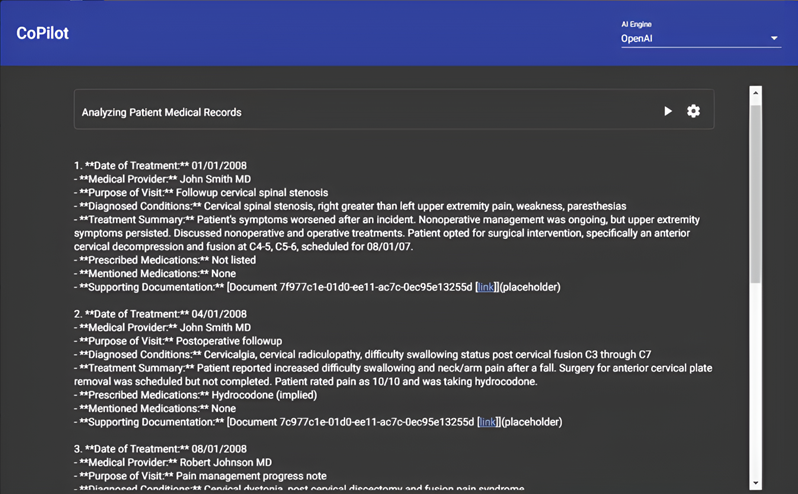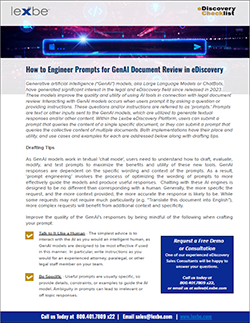Generative AI in eDiscovery Resource Center

Learn How to Harness the Power of Generative Artificial Intelligence (GenAI) in eDiscovery with Lexbe's GenAI in eDiscovery Resource Center
Welcome to Lexbe’s comprehensive resource hub for GenAI in eDiscovery! In thes resource center you’ll learn how to use ChatGPT and GenAI in eDiscovery. As the legal landscape evolves, leveraging advanced AI
technologies like Generative AI LLMs (Large Language Models) has become
imperative for legal professionals seeking efficiency and precision. Our
platform offers a suite of tools designed to empower lawyers and paralegals to
optimize their eDiscovery processes through transformative AI capabilities.
Checklists: How To Use ChatGPT and GenAI in eDiscovery
We developed these checklists to help guide you through the process of assessing and utilizing GenAI in your organization. The technology continues to improve at a rapid pace and it can be of high utility for augmenting your current technology and capabilities.
GenAI Use Cases
GenAI can help augment the capabilities of your team as well as automate several eDiscovery tasks. Here are some of the use cases where GenAI can be highly valuable:
Automated Document Review
GenAI can improve your document review process because it can quickly analyze and categorize vast amounts of data while also providing a confidence score and the rationale for responsiveness or privilege. Our testing has shown that it can perform better than traditional technology assisted review (TAR) and continuous active learning (CAL). With Lexbe AutoPilot we engineer the prompts, measure precision and recall, and help quality control the productions.

Summarize Documents
Effortlessly summarize single or multiple documents to capture essential information, enabling quick decision-making and improved case strategy. In the example below we utilized our secure integration with ChatGPT 4 to summarize multiple medical records and identify the dates of treatment, medical providers, purpose of the visits, diagnosed conditions, treatment summaries and much more. In addition to summarizing medical records, a primary summarization use case is leveraging GenAI’s robust capabilities to summarize depositions.

Event and Entity Identification
Identify key events and entities within your documents. GenAI large language models are trained on a massive corpus of documents and therefore are highly proficient at identifying events and entities. Gaining insight into the events and entities early in your case can be instrumental in crafting a better strategy.
Issue Identification
Similar to identifying key events and entities in your case, GenAI is a powerful assistant for pinpointing and highlight relevant issues automatically. This feature is crucial for managing complex cases efficiently.
Timeline Creation
Automatically generate timelines from your case files, providing a chronological sequence of events that are easy to understand and present.
Deciphering Acronyms
GenAI can define acronyms within the context of your documents, saving time and clarifying communications. This is of particular utility when reviewing documents related to industries, like telecommunications, that extensively utilizes acronyms.
PII/PHI Identification
Ensure compliance and protect sensitive information with GenAI detecting Personally Identifiable Information (PII) and Protected Health Information (PHI) in your documents. This is fast and helps you mitigate unwanted disclosures.
Multilingual eDiscovery
If you’re involved with cross-border litigation, then GenAI can easily assist by translating documents on the fly as you’re conducting your review.
Early Case Assessment
By utilizing GenAI you can rapidly gain insights into your case and establish the foundation for your arguments. Because these large language models are trained on a massive corpus of data, they’re highly effective at identifying the key issues, nuances, and entities in your case documents.
You Can Ask It Anything
If you have specific questions about your case, simply ask and you can usually get your questions answered with a high level of precision.
Webinars and Videos on How to Utilize GenAI in eDiscovery
Lexbe is on the forefront of GenAI in eDiscovery. We produce a lot of educational videos and webinars on how this rapidly emerging technology will have a landscape changing impact on eDiscovery. Check back often for new videos and follow-us on YouTube and LinkedIn to stay on top of the latest GenAI eDiscovery best practices, trends, and use cases.
Security of GenAI for Use in eDiscovery
To maximize security when using GenAI tools for eDiscovery without disclosing or compromising case data, it’s crucial to employ several best practices. It is important to configure the AI models to operate in a zero-knowledge or data privacy mode, where the model processes data without storing or having continued access to it. Legal and eDiscovery use cases qualify for the zero-knowledge and zero data retention accounts. Make sure you sign-up for the correct account type that will secure your case data. Implement robust access controls and encryption both for data at rest and in transit. Regularly audit and update security protocols to guard against evolving cyber threats. Finally, provide comprehensive training to users on the importance of data security and the correct use of AI tools to prevent accidental data leaks.
At Lexbe, we utilize zero data retention integrations and advanced data security safeguards to mitigate the risk of accidental data leaks.
It is also important to review the privacy policies of the large language models that you’ll be using for your cases. Here is a list for you to reference when you’re ready to get started.
The Role of GenAI Prompts in eDiscovery
Generative artificial intelligence (“GenAI”) models, aka Large Language Models or ChatBots, have generated significant interest in the legal and eDiscovery field since released in 2023. These models improve the quality and utility of using AI tools in connection with legal document review. Interacting with GenAI models occurs when users prompt it by asking a question or providing instructions. These questions and/or instructions are referred to as ‘prompts.’ Prompts are text or other inputs sent to the GenAI models, which are utilized to generate textual responses and/or other content. Within the Lexbe CoPilot GenAI capabilities, users can submit a prompt that queries the content of a single specific document, or they can submit a prompt that queries the collective content of multiple documents.
Both implementations have their place and utility, and use cases and examples for each are addressed below along with drafting tips. Drafting Tips As GenAI models work in textual ‘chat mode’, users need to understand how to draft, evaluate, modify, and test prompts to maximize the benefits and utility of these new tools. GenAI responses are dependent on the specific wording and context of the prompts. As a result, ‘prompt engineering’ involves the process of optimizing the wording of prompts to more effectively guide the models and produce useful responses. Chatting with these AI engines is designed to be no different than corresponding with a human. Generally, the more specific the request, and the more context provided, the more accurate the response is likely to be. While some requests may not require much particularity (e.g. “Translate this document into English”), more complex requests will benefit from additional context and specificity.


